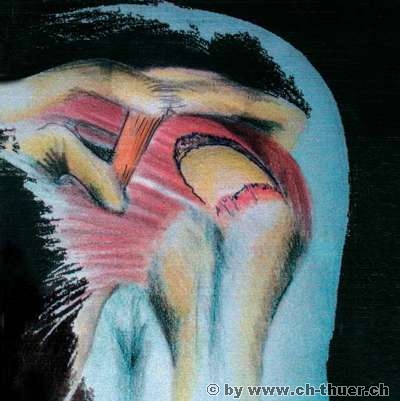|
According to recent MRI investigations we know that a rotator cuff injury does not heal spontaneously or with conservative treatment, since the force of gravity that drags the arm downwards and the direction of pull of the RC are in opposition. As a result, the torn edges are gradually pulled apart, leading to the formation of a growing hole in the tendon hood.
Many patients with shoulder symptoms report having experienced a trauma to the shoulder in the past, but the symptoms had subsequently disappeared. They had been able to resume sport and perform all kinds of tasks without any pain. A new, and in some cases trivial, trauma then leads to decompensation, and the clinical and instrumental investigations not infrequently reveal substantial damage to the RC. This prompts insurers to conclude that the lesion is a degenerative change and therefore to refuse to pay the costs of treatment. A more likely explanation, however, is that a partial rupture of the RC had occurred during the first incident, but the symptoms had resolved thanks to the body's natural powers of compensation. However, the weakened RC was then increasingly unable to perform its centring task properly. This results in a chronic impingement syndrome with further damage to the tendon cuff, which can then tear during a new, and in some cases trivial, trauma episode. In the words of the insurance company, this new trauma is "not adequate", which likewise cannot be denied. But attributing the whole situation to the patient's age or so-called normal, age-related degenerative changes does not get us any closer to the actual state of affairs either. As you know, all these considerations and findings have led to the familiar disputes between accident insurers, health insurance schemes and patients. Whole armies of lawyers make a good living from them.
The sudden tearing of the RC is usually associated with a considerable loss of function in the arm. Although mobility returns to normal thanks to the extraordinary ability of the rest of the shoulder girdle muscles to compensate for this lesion, persistent pain or a lack of strength usually prompts patients to visit their GP or a shoulder specialist. Patients' quality of life is substantially impaired, particularly if the shoulder is painful at night.
The latter is easy to explain. During the day, the arm is pulled downwards slightly by the force of gravity, which provides a certain degree of relief by making more space available for the RC beneath the acromion. At night, when the patient is lying down, there is no long any gravitational pull and the head of humerus is pulled upwards by the muscle tone of the remaining shoulder girdle muscles. As a result, the injured cuff is jammed up against the acromion.
RC ruptures can be investigated by clinical examination, ultrasound and, most reliably, by an arthro-MRI.
Whereas it was rare for such injuries to be surgically managed in the past because the postoperative results were not good enough, the attitude of shoulder specialists to the treatment of these injuries has now changed. Precisely because we know that tears cannot heal spontaneously and that lesions will progress if treatment is delayed excessively and almost invariably develop into a difficult or even insoluble problem, specialists now recommend that tears be treated surgically at an early stage when the tissue is still in good condition and reconstruction is still likely to produce a good outcome. The larger the defect to be treated, the more complicated the procedure, and the more difficult it is to predict the outcome. To be able to offer the patient the prospect of a good result with a certain degree of confidence, reconstruction of RC injuries should always be undertaken by highly experienced specialists who are well versed in shoulder surgery. Managing major RC defects even requires virtuosity. Open reconstruction with concurrent widening of the roof and other work on the surrounding tissues usually produces very good results. Arthroscopic reconstruction of the RC cannot yet guarantee the same results as open surgery and is not as effective.
In the following drawings I should like to illustrate the possible variants of RC reconstruction. No two ruptures look the same. Each has to be managed individually and as effectively as possible, which means that the surgeon must be able to adapt effectively to the local circumstances, the size and shape of the lesion, the condition of the torn tissue, etc.
|
